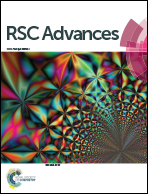Zeolitic imidazole framework derived N-doped porous carbon/metal cobalt nanoparticles hybrid for oxygen electrocatalysis and rechargeable Zn–air batteries†
Abstract
Bifunctional electrocatalysts with high catalytic property for the oxygen reduction reaction (ORR) and oxygen evolution reaction (OER) are vital for high-performance zinc–air batteries (ZnABs). In this study, an efficient bifunctional electrocatalyst with hollow structure (C–N/Co (1/2)) has been successfully prepared through carbonization of ZIF-8@ZIF-67 and evaporation of Zn ions at high temperature. With Co nanoparticles encapsulated by an N-doped porous carbon matrix, the catalyst exhibits excellent stability in aqueous alkaline solution over an extended period and good tolerance to the methanol crossover effect. The integration of an N-doped graphitic carbon outer shell and Co nanoparticles enables high ORR and OER activity, as evidenced by ZnAB using the catalyst C–N/Co (1/2) in an air cathode.



 Please wait while we load your content...
Please wait while we load your content...